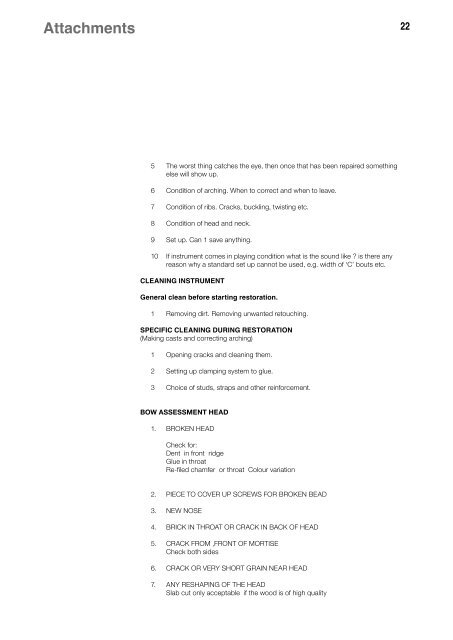advanced violin restoration techniques - International Specialised ...
advanced violin restoration techniques - International Specialised ...
advanced violin restoration techniques - International Specialised ...
Create successful ePaper yourself
Turn your PDF publications into a flip-book with our unique Google optimized e-Paper software.
Attachments<br />
5 The worst thing catches the eye, then once that has been repaired something<br />
else will show up.<br />
6 Condition of arching. When to correct and when to leave.<br />
7 Condition of ribs. Cracks, buckling, twisting etc.<br />
8 Condition of head and neck.<br />
9 Set up. Can 1 save anything.<br />
10 If instrument comes in playing condition what is the sound like ? is there any<br />
reason why a standard set up cannot be used, e.g. width of ‘C’ bouts etc.<br />
CLEANING INSTRUMENT<br />
General clean before starting <strong>restoration</strong>.<br />
1 Removing dirt. Removing unwanted retouching.<br />
SPECIFIC CLEANING DURING RESTORATION<br />
(Making casts and correcting arching)<br />
1 Opening cracks and cleaning them.<br />
2 Setting up clamping system to glue.<br />
3 Choice of studs, straps and other reinforcement.<br />
BOW ASSESSMENT HEAD<br />
1. BROKEN HEAD<br />
Check for:<br />
Dent in front ridge<br />
Glue in throat<br />
Re-filed chamfer or throat Colour variation<br />
2. PIECE TO COVER UP SCREWS FOR BROKEN BEAD<br />
3. NEW NOSE<br />
4. BRICK IN THROAT OR CRACK IN BACK OF HEAD<br />
5. CRACK FROM ,FRONT OF MORTISE<br />
Check both sides<br />
6. CRACK OR VERY SHORT GRAIN NEAR HEAD<br />
7. ANY RESHAPING OF THE HEAD<br />
Slab cut only acceptable if the wood is of high quality<br />
22

















